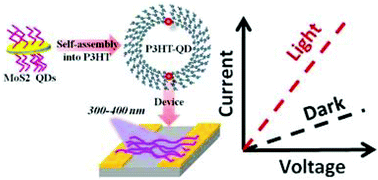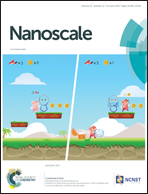Exceptional photoconductivity of poly(3-hexylthiophene) fibers through in situ encapsulation of molybdenum disulfide quantum dots†
Abstract
Photo-responsive, electrically conductive nanostructures are highly desirable for wide-ranging applications in energy harvesting, nanophotonic and optoelectronic devices. To this end, we realize self-assembled, photoconductive hybrids of poly(3-hexylthiophene) (P3HT) micro- and nano-fibers integrated with MoS2 quantum dots (QDs). We present an innovative strategy to impregnate QDs within the walls of the P3HT fibers resulting in the emergence of the controllable photoconductivity of the QD-P3HT hybrid. The maximum photoconductivity (>80% higher than pristine P3HT) is observed at 360 nm and originates from a synergistic combination of (a) defect healing and quenching of surface trap states in QDs by P3HT and (b) efficient generation and transfer of photo-excited charges from P3HT to QDs. This mechanism is substantiated by a concomitant decrease in the excited-state lifetime of the QD-P3HT hybrid. Furthermore, a linear correlation between the enhancement in the emission of QDs and the emission quenching of P3HT supports the proposed mechanism of excited-state charge transfer. Finally, the hybrid of MoS2 nanosheets (NS) with P3HT fibers (NS-P3HT) does not exhibit any photo-conductivity and instead exhibits ground state charge transfer, underlying the critical role of quantum confinement effects operating in the QD-P3HT hybrid. Thus, we demonstrate a synergistic, self-assembled QD-P3HT hybrid exhibiting optically controllable electrical conductivity in the solid state as novel functional materials for optoelectronic applications.



 Please wait while we load your content...
Please wait while we load your content...